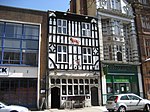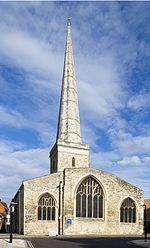Holyrood Church
1320 establishments in England14th-century church buildings in EnglandBritish Merchant NavyBritish churches bombed by the LuftwaffeChurch of England church buildings in Hampshire ... and 9 more
Church ruins in EnglandChurches completed in 1320Churches in SouthamptonEngvarB from September 2013Grade II* listed churches in HampshireGrade II* listed ruinsHistory of SouthamptonRuins in HampshireRuins of churches destroyed during World War II

Holyrood Church (or Holy Rood Church) was one of the original five churches serving the old walled town of Southampton, England. Built in 1320, the church was destroyed by enemy bombing during the blitz in November 1940. In 1957 the shell of the church was dedicated as a memorial to the sailors of the Merchant Navy. It is a Grade II* listed building.
Excerpt from the Wikipedia article Holyrood Church (License: CC BY-SA 3.0, Authors, Images).Holyrood Church
Bernard Street, Southampton St Mary's
Geographical coordinates (GPS) Address External links Nearby Places Show on map
Geographical coordinates (GPS)
| Latitude | Longitude |
|---|---|
| N 50.89966 ° | E -1.40353 ° |
Address
Church of Holyrood
Bernard Street
SO14 2DB Southampton, St Mary's
England, United Kingdom
Open on Google Maps










